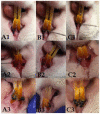Induction of Periodontitis Using Bacterial Strains Isolated from the Human Oral Microbiome in an Experimental Rat Model
- PMID: 37626595
- PMCID: PMC10452127
- DOI: 10.3390/biomedicines11082098
Induction of Periodontitis Using Bacterial Strains Isolated from the Human Oral Microbiome in an Experimental Rat Model
Abstract
Periodontal disease is that condition resulting in the destruction of periodontal tissues, bone resorption, and tooth loss, the etiology of which is linked to immunological and microbiological factors. The aim of this study was to evaluate the potential trigger of periodontal disease in a rat model using bacterial species incriminated in the pathology of human periodontitis and to establish their optimal concentrations capable of reproducing the disease, with the idea of subsequently developing innovative treatments for the condition. In this study, we included 15 male Wistar rats, aged 20 weeks, which we divided into three groups. In each group, we applied ligatures with gingival retraction wire on the maxillary incisors. The ligature and the gingival sac were contaminated by oral gavage with a mixture of fresh cultures of Aggregatibacter actinomycetemcomitans (A.a), Fusobacterium nucleatum (F.n) and Streptococcus oralis (S.o) in concentrations of 108, 109, and 1010 CFU/mL each for 5 days a week for 4 weeks. During the clinical monitoring period of 28 days, overlapped with the period of oral contamination, we followed the expression of clinical signs specific to periodontitis. We also monitored the evolution of body weight and took weekly samples from the oral cavity for the microbiological identification of the tested bacteria and blood samples for hematological examination. At the end of the study, the animals were euthanized, and the ligated incisors were taken for histopathological analysis. The characteristic symptomatology of periodontal disease was expressed from the first week of the study and was maintained until the end, and we were able to identify the bacteria during each examination. Hematologically, the number of neutrophils decreased dramatically (p < 0.0001) in the case of the 109 group, unlike the other groups, as did the number of lymphocytes. Histopathologically, we identified neutrophilic infiltrate in all groups, as well as the presence of coccobacilli, periodontal tissue hyperplasia, and periodontal lysis. In the 109 group, we also observed pulpal tissue with necrotic bone fragments and pyogranulomatous inflammatory reaction. By corroborating the data, we can conclude that for the development of periodontal disease using A.a, F.n, and S.o, a concentration of 109 or 1010 CFU/mL is required, which must necessarily contaminate a ligature thread applied to the level of the rat's dental pack.
Keywords: Aggregatibacter actinomycetemcomitans; Fusobacterium nucleatum; Streptococcus oralis; ligature; periodontitis; rat.
Conflict of interest statement
The authors declare no conflict of interest.
Figures






References
LinkOut - more resources
Full Text Sources
Molecular Biology Databases

